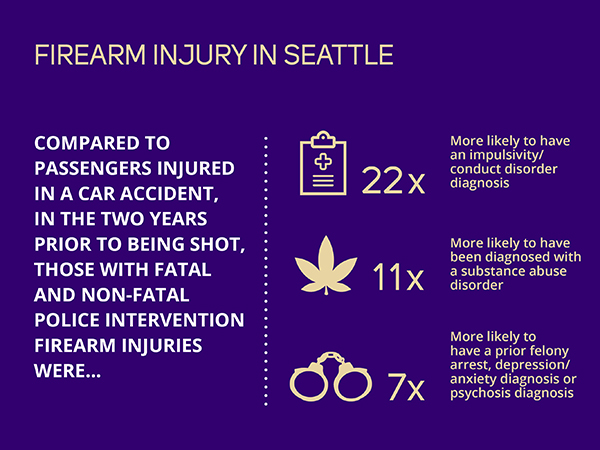Police, hospital records show warning signs of future firearm injury
An individual’s history of substance use, mental disorder and arrest can indicate an elevated risk of getting shot, according to a new study from the University of Washington School of Public Health. These warning signs illustrate the growing challenges healthcare and police personnel face in recognizing someone at risk of firearm injury.
The study, published in the American Journal of Preventive Medicine on Thursday, is one of the first studies to examine how certain behaviors can be used as warning signs for individuals at risk of getting shot in a crime, by police, unintentionally or by means of suicide.
Lead author Brianna Mills, a recent doctoral graduate from the Department of Epidemiology, compared the cases of 763 individuals injured or killed by a gun in Seattle between 2010 and 2014 with a control group of passengers injured or killed in a car accident in Seattle during the same years. She grouped firearm injuries and fatalities into four categories: crime-related, suicide-related, unintentional, and police intervention injuries. Mills examined the arrest histories and mental disorder and substance abuse diagnoses for each category during the two years prior to injury using data maintained by the Washington State Department of Health and Washington State Patrol.

Mills found that individuals in the police intervention injuries group had arrest histories similar to those with crime-related injuries but also had hospitalization histories similar to those with suicide-related injuries. Compared to the control group, these individuals were seven times more likely to have a prior felony arrest; four times more likely to have a diagnosis involving alcohol and eleven times more likely to have one for cannabis abuse; seven times more likely to have clinical depression, anxiety or psychosis; and 22 times more likely to have a conduct disorder. Their median time between last hospitalization and getting shot by police was two months.
“When we looked at the results for the first time, we didn’t expect to see such extreme results in the police intervention group,” said Mills, now a research scientist at the Harborview Injury & Prevention Research Center. “I hope this starts more conversations among police and healthcare personnel about the interactions they may have with someone that should be interpreted as red flags, as signs that they need help.”
Mills cautions against interpreting these results as sure signs that individuals with mental disorders, substance abuse, or arrest histories will get shot. Instead, this study should help raise awareness that individuals most at risk of getting shot have several encounters with institutions prior to the event. These are key points of intervention that should be recognized by both healthcare and police personnel. More research should be done in other U.S. cities to see if the results follow a national trend or reflect a specific phenomenon in Seattle.
“This is one study, a snapshot of five years of injuries in one city,” Mills said. “I don’t want to make any broadscale claims about what should or shouldn’t be done until we have a chance to see how this type of study works in other cities. This data exists in other places and we could potentially see really interesting community-specific patterns if we reproduce this study elsewhere.”
This study was part of Mills’ doctoral dissertation while at the University of Washington Department of Epidemiology. It was supported by the Center for Studies in Demography and Ecology Shanahan Fellowship and the Harborview Injury Prevention & Research Center.